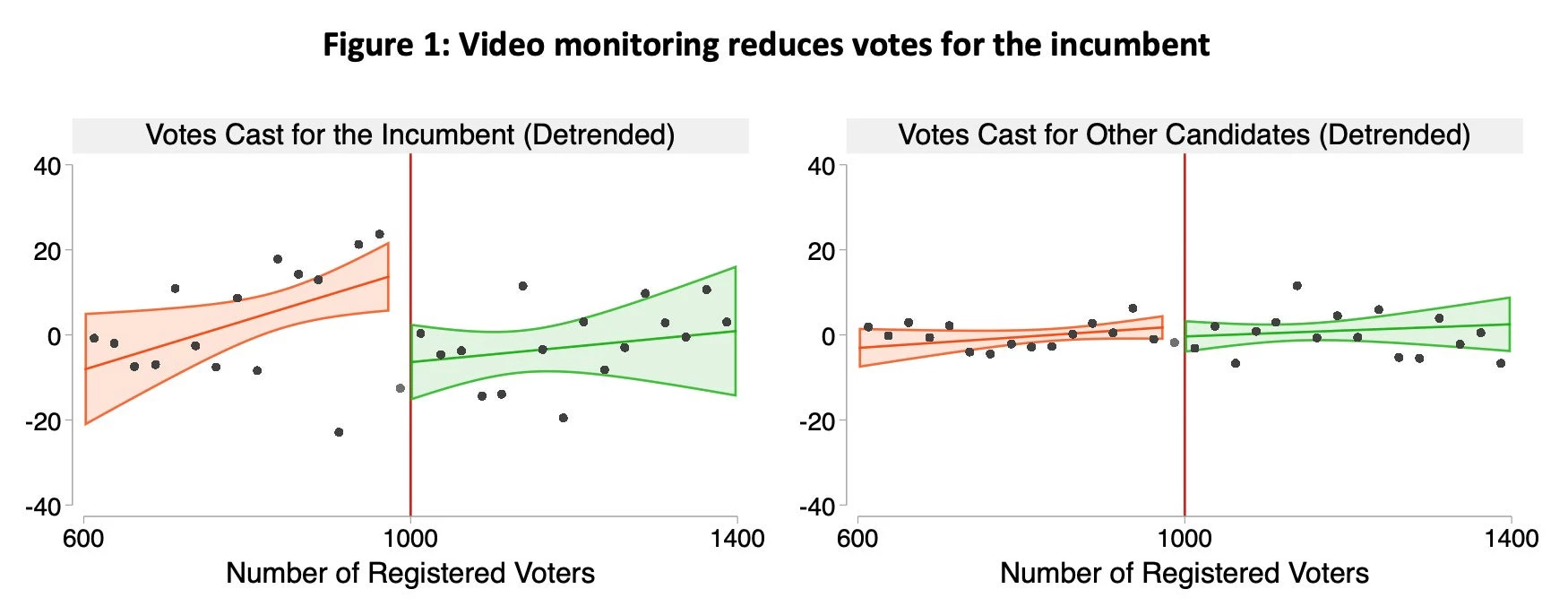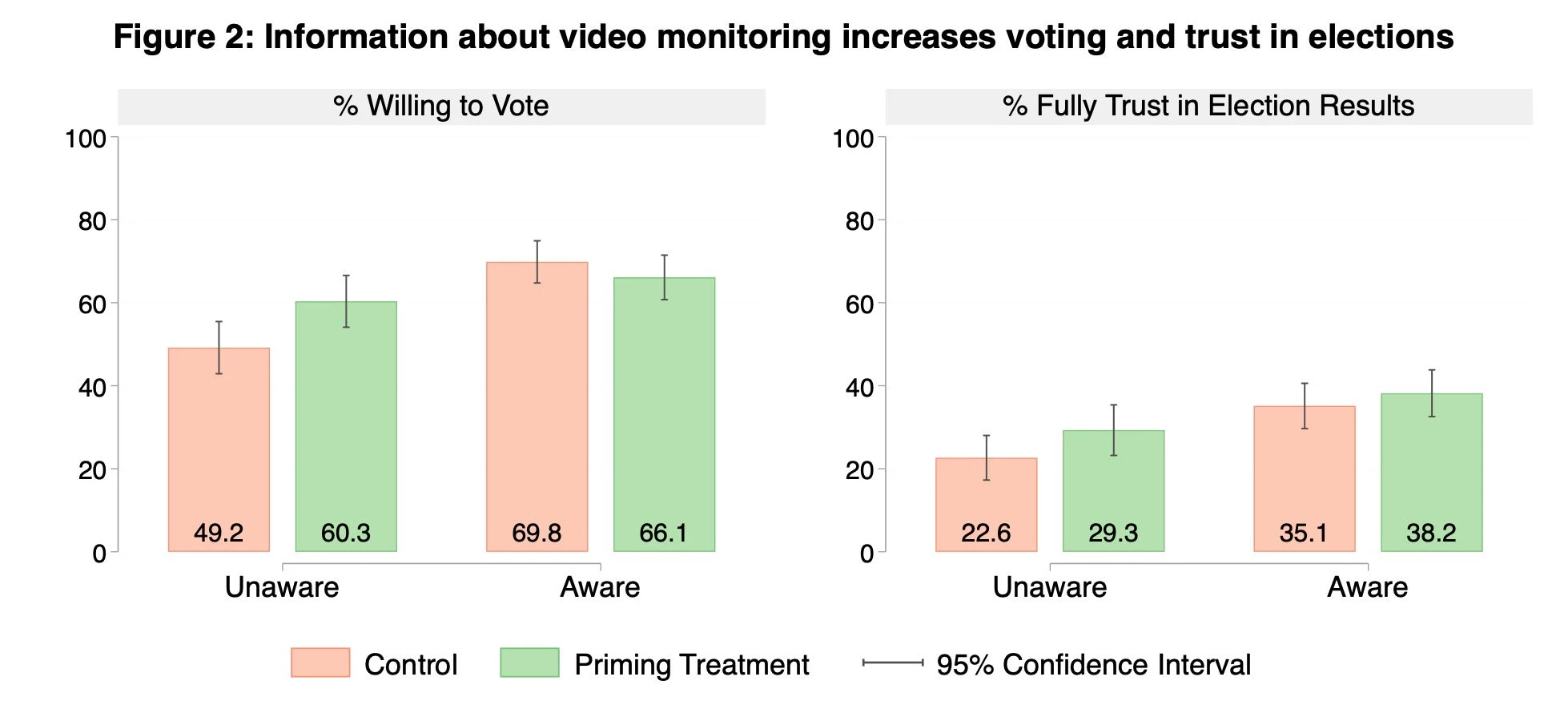This is the fourth in this year’s series of posts by PhD students on the job market.
The last decade has seen the backsliding of democracy worldwide (Freedom House, 2021). Nowadays, 43% of the world’s population and 87% of the poor live in hybrid and authoritarian regimes. These modern non-democratic regimes imitate core democratic institutions and hold elections at different levels of government (Guriev and Treisman, 2019). More than 80% of non-democracies elect legislatures on a regular basis (DPI, 2020). In turn, many domestic and international organizations actively conduct election observation missions and sponsor transparency-enhancing technologies with the goal of improving electoral and political accountability in these countries. This raises the question: do electoral transparency initiatives help promote democracy or strengthen non-democratic regimes?
In my job market paper, I study the effects of election video monitoring and explore possible reasons behind its use in Russia, a large emerging economy and a non-democratic state (Polity IV score of 4 in 2018). This technology places webcams inside polling stations, which then broadcast voting online. Various countries have increasingly adopted video monitoring, including Albania, Armenia, Azerbaijan, Georgia, India, Israel, and Ukraine. Many counties in the United States also install webcams in vote-counting centers.
I first estimate the local effects of video monitoring on election outcomes by exploiting a discontinuity in the assignment of webcams and show evidence of a reduction in fraud at monitored polling places. However, around half of this effect is offset by increased fraud at neighboring unmonitored polling stations. Using a survey experiment, I show that video monitoring helps the government improve citizens’ attitudes by creating an illusion of transparency.
Impacts of Video Monitoring on Electoral Accountability
During the 2018 presidential election in Russia, the Central Election Commission suggested installing webcams inside polling stations with more than 1,000 registered voters. I employ a regression discontinuity design around this cutoff and combine it with election data from 23,000 polling stations covering 25 million registered voters (23.3% of all voters). Specifically, I compare election outcomes at polling stations whose voter coverage is immediately above the cutoff for video monitoring to those at polling places just below it. On average, eligible polling stations have an approximately 60 percentage points higher probability of video monitoring. I show that there is no manipulation of voter registration, no placebo effects using prior elections and alternative cutoffs, and no discontinuities in other observable polling station characteristics.
Figure 1 shows that polling stations eligible for video monitoring have around 25 fewer votes cast for the incumbent. This effect is equivalent to an approximately 8.3% reduction in votes or a one percentage point decrease in the incumbent’s vote share (accounting for the first stage). This reduction in votes does not threaten the incumbent’s win, given their average vote share of 75.5% under the absolute majority system. However, it slightly reduces their popularity and legitimacy of elections by lowering the reported turnout from 67.7% to 64.2%. There are no significant effects on votes cast for other candidates.

These effects are consistent with a reduction in election fraud known as ballot-box stuffing. Using an election forensics tool, I find that video monitoring significantly reduces a share of polling stations that have abnormally high values of turnout and incumbent’s vote share; this pattern is commonly observed in countries with fraudulent elections.
I also find that video monitoring partially displaces fraud in favor of the incumbent to neighboring unmonitored polling places. A rough estimate suggests that the displacement offsets more than half of the reduction in votes, making improvements in electoral accountability even smaller.
Does video monitoring improve political accountability?
Economists often consider fair elections as the primary accountability mechanism that helps align the incentives of politicians with the preferences of citizens (Besley, 2006). I explore whether video monitoring improves political accountability by looking at the value of completed public procurement projects before the election. I instrument the intensity of video monitoring in each district with the share of eligible polling stations around the cutoff of 1,000 voters. I do not find evidence of differential changes in public spending or its re-allocation across sectors in districts with a higher intensity of video monitoring. Hence, there are no observable accountability effects of monitoring on public goods spending.
Why does a non-democracy need election video monitoring?
One possible reason is that it helps improve citizens’ attitudes toward the government by creating an illusion of transparency. The regression discontinuity design cannot fully capture these effects because voters react to general information about video monitoring rather than its placement in a particular polling station. To resolve this empirical challenge, I conducted a survey experiment for a nationally representative sample of 1,097 respondents two weeks before the 2019 local elections. The priming treatment provided information to a random half of respondents that many polling stations in the upcoming elections would have video monitoring.
Figure 2 shows that information about video monitoring increases respondents’ willingness to vote. 49.2% of respondents unaware of transparency policies (proxied by awareness of transparent ballot boxes) intend to vote in the control group. This share increases by 11.1 percentage points or 23% in the priming treatment group. Similarly, video monitoring increases their willingness to vote for the ruling United Russia party from 25.8% to 34.5%. In contrast, aware respondents have a higher baseline willingness to vote and support the regime, which do not significantly change with the priming treatment. This stands to reason: if voters are already aware of monitoring, then my treatment does not reveal new information.

These effects are not driven by voter intimidation despite its high baseline level of 26% (measured using a list experiment). Instead, they are driven by increased trust in elections. Only 22.6% of unaware respondents fully trust in the fairness of results in the control group. The priming treatment increases this share by 6.7 percentage points, equivalent to a 30% increase.
Policy Implications
These findings provide policy implications for domestic and international organizations that actively invest in the transparency of elections worldwide, including USAID, the Carter Center, the National Democratic Institute, and the ODIHR. They should recognize that their activities, including election monitoring, might trigger a strategic response by non-democratic states and adjust accordingly. For example, they might insist that all polling stations should be monitored to prevent the displacement of fraud. Alternatively, they might reassess whether election monitoring is effective at all.
Anastasiia Faikina is a PhD candidate in the Economics Department at the University of California San Diego. She uses experimental and quasi-experimental methods to study the intended and unintended effects of digital technologies and reforms designed to improve governance in low- and middle-income countries. Learn more about her research at: https://www.anastasiiafaikina.com/.


Join the Conversation